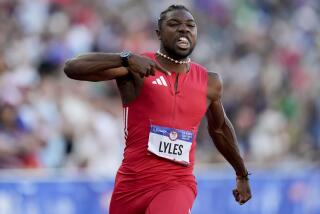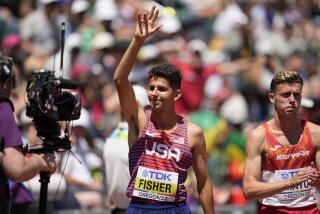In This Race, Comparisons to America’s Cup Runneth Over
- Share via
Does this scenario sound familiar?
The defender is an Australian, who hadn’t been expected to win in the first place.
Two of the challengers, perhaps the best of the challengers, are from the United States and New Zealand.
The venue will be quite different and so will the characters, but this is beginning to sound like America’s Cup revisited. Loosen the boom and bloom the spinnaker, mate, because these countries are going to be at it again.
However, this will not be like the four-month campaign waged on the waters of the Indian Ocean.
These competitors will get it done in less than four minutes. That is how long it will take to run the mile at the Michelob Invitational in the Sports Arena Feb. 22. It will be over and done in almost no time at all.
Zap. Pow. Slam dunk.
The defender, in this case, is not a Kookaburra by any Roman numeral. He is not backed by any multimillion dollar syndicates. He is not the product of a design team adding little winglets to a keel. There won’t be one of him for the start and another for the remainder of the race.
He is Michael Hillardt. Period.
In yachting, he would be Hillardt I. In international track and field, Hillardt wants to be No. 1.
A year ago, in this same race, he was No. 1. It was as unexpected as the Aussies winning the America’s Cup in 1983. Hillardt was a solid international competitor, but fellows such as Eamonn Coghlan, Steve Scott and John Walker were much more familiar names. Hillardt probably would have gone off at 15-1. At least.
Hillardt won it in 3:56.6. It was not fast as Sports Arena miles go, but no one was any faster.
Ironically, it should not have been such a great surprise that Hillardt defeated such a field. He has a best of 3:51.8 in the mile, and he has beaten most of the world’s great milers at some time or another.
Hillardt’s “upset” win probably typified the world’s attitude toward the folks Down Under. Australia lives what might be called an out-of-sight, out-of-mind existence. Thus, Hillardt was able to come up here as anonymously as a Qantas pilot and steal the thunder in a major track meet.
Of course, much has changed for Australia of late.
“The America’s Cup is part of it,” he said, “and Paul Hogan, the actor, has also helped put Australia on the map . . . and so have a lot of tour ads. We’ve gotten a lot of recognition from people who have never thought much about us before.”
We are talking different images here. Hogan’s “Crocodile Dundee” presented a very primitive view of Australia, more like that of an uneducated trapper being pulled out of the North Dakota Badlands and presented to the world as a typical American. The America’s Cup was a far more flattering representation of both high-tech progress and competitive spirit.
That Dennis Conner should have retrieved the cup does not detract from the fact that the Aussies had it in the first place.
Like his countrymen, Hillardt followed the cup competition.
“It was hard not to,” he said. “The coverage was constant. Sometimes, I think the saturation was too much.”
Hillardt described Conner the way he might describe a wily miler.
“I guess it was up to Dennis Conner, really, to get the cup back,” he said. “I’m sure Dennis had some special feelings about it. And I think he schemed and played cat and mouse the whole series. He’d win a few and lose a few and look like he was struggling.”
And then?
“I think he was extremely confident all the while he was sitting back there and looking like he was in trouble,” Hillardt said. “He was ready to win when the time was right. He blew New Zealand out of the water and sailed against Australia like we weren’t even in the race.”
It occurred to me, as I listened to Hillardt, that the mile run might have parallels with the America’s Cup competition, though obviously much more compact and frenzied. There is a matter of staying within oneself while keeping an anxious eye on the opposition, building toward a peak near the finish and then performing at that climactic moment.
“You have to pace yourself,” Hillardt said, “but you have to keep on eye on who’s ahead of you. If it’s a guy who’s going to die after one lap, let him go. But you can’t let a strong runner take off quickly and get away.”
The tactical aspect is what has always so interested me about the mile run. Call it gamesmanship, if you will, but it was certainly a major part of Conner’s success.
Michael Hillardt will also try to be in position for a power play in the stretch run. He goes more for strength than for quickness and maneuverability. This Aussie would probably be Stars & Stripes if he were a yacht.
“I can’t wait until the last 200 and then pick up 10 yards quickly with acceleration,” he said. “I have to start my move with about 600 yards to go and build into it.”
It would be interesting to dissect this mile run every few hundred yards, getting inside the minds of the Aussie defender and the Yank and Kiwi challengers. It would probably sound much like the day-to-day (or week-to-week) observations coming out of Fremantle.
Is the Kiwi setting too fast a pace to last? Is the Yank sandbagging for a strong finish? Can anyone challenge this Aussie?
We can be quite thankful that the Michelob Mile will not feature the skippers from the America’s Cup itself. A mile run matching Dennis Conner and Australia’s Iain Murray would probably last 3:56, but that would translate to hours and minutes rather than minutes and seconds.
More to Read
Go beyond the scoreboard
Get the latest on L.A.'s teams in the daily Sports Report newsletter.
You may occasionally receive promotional content from the Los Angeles Times.










